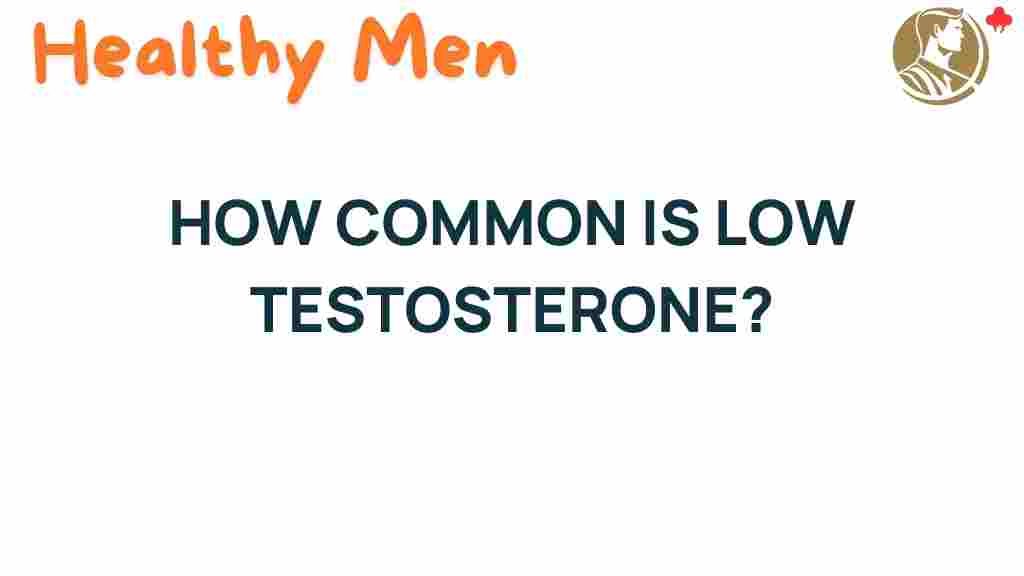Unveiling the Truth: How Common is Low Testosterone in Men?
Low testosterone, also known as male hypogonadism, is becoming an increasingly recognized issue in men’s health. While testosterone is often associated with masculinity, its importance extends far beyond that. Testosterone plays a crucial role in various bodily functions, and its deficiency can lead to a myriad of health issues. In this article, we will explore how common low testosterone is among men, the symptoms associated with it, diagnosis methods, treatment options, and the impact of age-related changes and lifestyle factors.
Understanding Low Testosterone
Testosterone is a hormone produced primarily in the testes and is responsible for the development of male physical characteristics. However, testosterone levels can vary greatly and may decline due to several factors, leading to a hormonal imbalance.
How Common Is Low Testosterone?
Low testosterone is not as rare as one might think. Research indicates that approximately:
- About 2% to 4% of men in their 40s have low testosterone levels.
- This percentage increases to 20% to 30% in men over the age of 60.
- By age 80, nearly 50% of men may experience low testosterone levels.
These statistics reveal that low testosterone is a significant concern in men’s health, especially as they age.
Symptoms of Low Testosterone
Identifying the symptoms of low testosterone is essential for early diagnosis and management. Common symptoms include:
- Decreased libido (sex drive)
- Fatigue and lack of energy
- Depression and mood swings
- Difficulty concentrating or memory issues
- Reduced muscle mass and strength
- Increased body fat
- Bone density loss
- Hair loss
If you experience several of these symptoms, it may be time to consult a healthcare professional for further evaluation.
Diagnosis of Low Testosterone
Diagnosing low testosterone typically involves a thorough assessment by a healthcare provider. The process includes:
- Medical History Review: Discussing symptoms, medical history, and any medications taken.
- Physical Examination: A physical exam to check for signs of hormonal imbalance.
- Blood Tests: Measuring testosterone levels through blood tests, usually done in the morning when testosterone levels are highest.
It’s critical to have testosterone levels measured correctly, as levels can fluctuate throughout the day.
Treatment Options for Low Testosterone
If diagnosed with low testosterone, various treatment options are available. The most common include:
- Testosterone Therapy: This is the most direct treatment for low testosterone. It can be administered through injections, patches, gels, or pellets inserted under the skin.
- Addressing Underlying Conditions: Conditions such as obesity, diabetes, and hormonal disorders can contribute to low testosterone. Treating these can help improve testosterone levels.
- Lifestyle Changes: Adopting a healthier lifestyle can significantly impact testosterone levels. This includes maintaining a healthy diet, regular exercise, and managing stress.
It’s important to discuss the benefits and risks of testosterone therapy with a healthcare provider, as it may not be suitable for everyone.
Age-Related Factors
As men age, testosterone levels naturally decline. Starting in their 30s, testosterone levels drop about 1% per year. This gradual decline can lead to symptoms of low testosterone and may affect men’s health significantly. Awareness of this natural process can lead to better management and treatment of symptoms when they arise.
Lifestyle Factors Influencing Testosterone Levels
Several lifestyle factors can contribute to low testosterone levels, including:
- Poor Diet: A diet high in processed foods and sugars can negatively impact hormone levels.
- Lack of Exercise: Sedentary lifestyles are linked to lower testosterone levels.
- Obesity: Excess body fat, particularly around the abdomen, can lead to hormonal imbalances.
- Stress: Chronic stress increases cortisol levels, which can negatively affect testosterone production.
- Alcohol and Substance Abuse: Excessive alcohol consumption and drug use can hinder testosterone levels.
Making positive changes in these areas can help improve overall men’s health and testosterone levels.
Step-by-Step Process for Addressing Low Testosterone
Here is a step-by-step process for addressing low testosterone:
- Recognize Symptoms: Be aware of the symptoms of low testosterone.
- Consult a Healthcare Provider: Schedule an appointment to discuss your symptoms and health history.
- Get Tested: Undergo blood tests to measure testosterone levels.
- Discuss Treatment Options: Review potential treatments with your healthcare provider.
- Implement Lifestyle Changes: Incorporate healthy habits that promote hormone balance.
- Monitor Progress: Follow up with your healthcare provider to monitor testosterone levels and symptoms.
Troubleshooting Tips for Managing Low Testosterone
If you’re managing low testosterone, here are some troubleshooting tips:
- Regular Follow-ups: Keep up with regular appointments to monitor your testosterone levels and overall health.
- Track Symptoms: Maintain a journal of symptoms to discuss with your provider during visits.
- Stay Informed: Educate yourself about low testosterone and its management options.
- Seek Support: Join support groups or forums to connect with others facing similar issues.
Addressing low testosterone is crucial for maintaining quality of life and overall health in men.
Conclusion
Low testosterone is a common issue that affects many men, particularly as they age. Understanding the symptoms, diagnosis, and treatment options available can empower men to take control of their health. By making lifestyle changes and seeking appropriate medical intervention, men can manage low testosterone effectively and improve their quality of life.
For more information on men’s health and hormonal imbalances, consider visiting Men’s Health Network. If you suspect you might have low testosterone, don’t hesitate to contact a healthcare professional to discuss your concerns and potential treatment options.
Ultimately, awareness and proactive management are key to navigating the challenges associated with low testosterone, ensuring that men can lead fulfilling and healthy lives.
This article is in the category Conditions and created by healthymen Team
